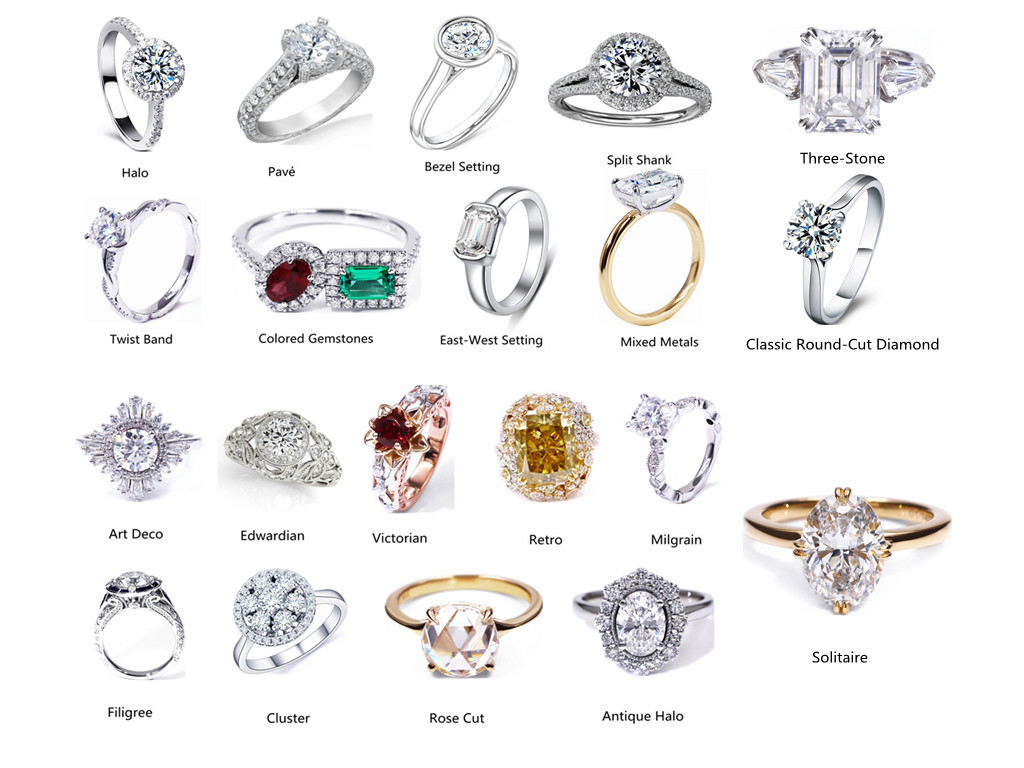Engagement Rings - An Overview
Engagement Rings - An Overview
Blog Article
Engagement Rings for Beginners
Table of ContentsThe Basic Principles Of Engagement Rings What Does Engagement Rings Mean?Engagement Rings - QuestionsNot known Details About Engagement Rings Engagement Rings for DummiesWhat Does Engagement Rings Mean?
Tension-style setups additionally give much better safety for the gemstone. Many tension-style settings are created rounded dazzling rubies or various other round gemstones, but they can be changed to fit many other forms. The setup can additionally be changed to have accent treasures around the centre rock or to enable a side stone on each side of the centre rock.Is not vulnerable and wears well. Can be customized. Develops a visual fallacy of the centre gems awaiting the air. Have a modern style that has lots of poise and elegance - engagement rings. Easy to clean up and maintain. If it has prongs, they can come to be loosened with wear. This is easily remedied by having the ring frequently cleaned and checked by a jeweler.
Get This Report about Engagement Rings
The initial ring with a real tension setting was made in Vreden, Germany in the 1970s. Ursula Exner and well-known artist Walter Wittek functioned with each other to design and make this first ring. In the adhering to years, various other jewelers developed their own tension setups, in addition to the more secure and functional tension-style settings.

This offers the ring a basic, but stylish elegance that functions well for both men and females's wedding rings, as well as involvement rings. The flush setting is sometimes additionally called a gypsy setting. We can't state for sure just how it came to have that name, yet probably it is due to the fact that the setup represents a totally free spirit.
The 3-Minute Rule for Engagement Rings
Flush settings function well for round, square or rectangular gems, but they can be tough to adjust to specific elegant cuts, for example, a heart-shaped ruby. Maintains the gems safe and secure. Wears particularly well. Practical for people with energetic lifestyles. Attracts attention for having a simple, yet fashionable charm.
Commonly unwise for heart-shaped treasures and a couple of other gems with fancy cuts. Rings with flush or gypsy settings have actually been around given that the late 1800s.
Solitaire interaction rings have only one centre gems on a plain band. Lots of various other engagement rings, however, likewise have accent gemstones. Accent treasures can be rubies or a range of various other jewels. They usually vary in size from small to moderate and are set close with each other. Accent gems are added to interaction rings particularly to raise radiance and sparkle.
Not known Facts About Engagement Rings
There are 4 setups that are commonly utilized to hold accent gemstones. The castle setting made its name since from the side it looks like the battlements on top of a castle wall surface. This setup is likewise frequently called the scallop setup. Castle settings are made directly on the shank of the ring.
The prongs in a castle setup can be right up and down with easy spherical ideas or they can be reduced at an angle so that they look like fishtails. Castle setups are extremely flexible.
The Best Guide To Engagement Rings
If it is well made, the reduced scalloped edge of the castle setup can also develop an optical impression. It enables the sides of the gems to be conveniently seen and creates the impact that the gems are being held in an undetectable setup.
Boosts light refraction he said and brilliance. Catches focus with its glimmers. Develops the impression of an unseen setting. Has a sophisticated appeal. Easy to tidy and needs Check Out Your URL little maintenance. The tiny prongs can become loosened. We advise that rings with the castle setting be cleaned sometimes by a jeweller, so that the prongs can be inspected.
The prongs on a castle setup can catch on apparel, yet this is unusual due to the fact that the prongs are smooth. The castle setting can be used to make lovely endless time rings. The very first eternity rings were made in the 1960s. Those original rings, like eternity rings today, have a row of carefully established gems entirely enclosing their shank.

Engagement Rings Can Be Fun For Everyone
The bead setting is a really protected setup. The sides of the network safeguard the accent treasures from bumps and scratches and the beaded prongs hardly ever become my company loosened. One downside of the grain setup is that the gems receive much less light because they are set down in the channel. This causes the gems generating slightly much less sparkle and glimmer.
Every treasure in the grain setting is bordered by 4 glossy grains that are degree with the top of the shank. These beads capture the light and release their own sparkles in every direction. The beads' sparkles with each other with the luster and shines created by the accent treasures bring the bead readying to life and offer it continual glimmers.
They can use it to make infinity rings, along with to embellish the simple shank or even more intricate split shank that some engagement rings have. In the fundamental bead setup, the accent treasures are set in one straight line. Occasionally, however, jewelers will certainly increase the shimmer on an involvement ring by adding 2 or even more identical lines of bead set treasures.
Report this page